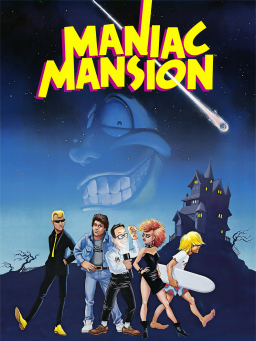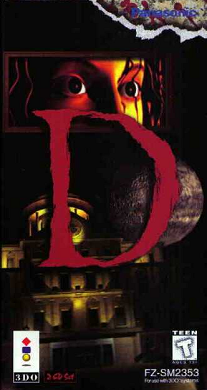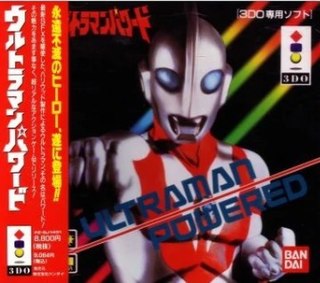
Maniac Mansion is a 1987 graphic adventure video game developed and published by Lucasfilm Games. It follows teenage protagonist Dave Miller as he attempts to rescue his girlfriend Sandy Pantz from a mad scientist, whose mind has been enslaved by a sentient meteor. The player uses a point-and-click interface to guide Dave and two of his six playable friends through the scientist's mansion while solving puzzles and avoiding dangers. Gameplay is non-linear, and the game must be completed in different ways based on the player's choice of characters. Initially released for the Commodore 64 and Apple II, Maniac Mansion was Lucasfilm Games' first self-published product.

The 3DO Interactive Multiplayer, also referred to as simply 3DO, is a home video game console developed by The 3DO Company. Conceived by entrepreneur and Electronic Arts founder Trip Hawkins, the 3DO was not a console manufactured by the company itself, but a set of specifications, originally designed by Dave Needle and RJ Mical of New Technologies Group, that could be licensed by third parties. Panasonic produced the first models in 1993, and further renditions of the hardware were released afterwards by GoldStar, Sanyo, Creative Labs, and Samsung Electronics in 1997.

Rise of the Robots is a fighting game released by Time Warner Interactive in 1994. Originally developed for the Amiga and DOS by Mirage's Instinct Design, it was ported to various video game consoles, including the Super NES, the Mega Drive, and the 3DO Interactive Multiplayer. The game includes a single-player mode in which the player assumes the role of the ECO35-2 Cyborg as he attempts to stop the Supervisor who takes over Electrocorp's facilities in Metropolis 4, and a two-player mode in which the second player controls a character chosen from among EC035-2's enemies.
Survival horror is a subgenre of horror games. Although combat can be part of the gameplay, the player is made to feel less in control than in typical action games through limited ammunition or weapons, health, speed, and vision, or through various obstructions of the player's interaction with the game mechanics. The player is also challenged to find items that unlock the path to new areas and solve puzzles to proceed in the game. Games make use of strong horror themes, such as dark mazelike environments and unexpected attacks from enemies.

Secret of Mana, originally released in Japan as Seiken Densetsu 2, is a 1993 action role-playing game developed and published by Square for the Super Nintendo Entertainment System. It is the sequel to the 1991 game Seiken Densetsu, released in North America as Final Fantasy Adventure and in Europe as Mystic Quest, and it was the first Seiken Densetsu title to be marketed as part of the Mana series rather than the Final Fantasy series. Set in a high fantasy universe, the game follows three heroes as they attempt to prevent an empire from conquering the world with the power of an ancient flying fortress.

Dr. Robotnik's Mean Bean Machine is a falling block puzzle game developed by Compile and published by Sega. It was released for the Sega Genesis / Mega Drive in North America and Europe in November 1993, and ported to the Game Gear in 1993 and Master System in 1994.
Alone in the Dark is a survival horror video game series originally developed by Infogrames. In most of the games, the player controls private investigator Edward Carnby, who goes to investigate a haunted house or town that is full of undead creatures.

Alone in the Dark 2 is a 1993 survival horror video game developed and published by Infogrames. It is the second installment in the Alone in the Dark series. It was ported to the PC-98 and FM Towns in 1994 and to the 3DO Interactive Multiplayer in 1995 under the same name, and to the Sega Saturn and PlayStation in 1996 as Alone in the Dark: Jack Is Back in Europe, and renamed as Alone in the Dark: One-Eyed Jack's Revenge in North America.

OverBlood is a science fiction video game developed by Riverhillsoft and published by Electronic Arts for the PlayStation in 1997. It is considered the first survival horror game to make use of a fully three-dimensional virtual environment. The game was released on the Japanese PlayStation Network Store on February 23, 2011.

D is a horror-themed interactive movie and adventure game developed by Warp and directed by Kenji Eno. It was first published by Panasonic for the 3DO Interactive Multiplayer in 1995, later being ported to the Sega Saturn, PlayStation, and MS-DOS. The story follows Laura Harris as she goes to investigate a hospital after learning her father went on a mass murdering spree and barricaded himself inside. The hospital morphs into a castle upon her arrival, which she must explore to find her father. The player controls Laura through computer generated full-motion video (FMV) sequences, and must complete the game within two hours without a save or pause function.

Alone in the Dark is a 1992 survival horror video game designed by Frédérick Raynal. Developed and published by Infogrames in 1992 for MS-DOS, the game was eventually ported to MacOS, the PC-98, the FM Towns, the 3DO, the Acorn Archimedes, and iOS. Alone in the Dark is set in 1920s Louisiana and challenges the player to escape a haunted mansion. To advance, the player must solve puzzles while banishing, slaying, or eluding various ghosts and monsters. The player can collect and use weapons, manage a weight-based inventory system, and explore a partially nonlinear map.

The Need for Speed is a 1994 racing game developed by EA Canada, originally known as Pioneer Productions, and published by Electronic Arts for 3DO in 1994. It allows driving eight licensed sports cars in three point-to-point tracks either with or without a computer opponent. Checkpoints, traffic vehicles, and police pursuits appear in the races.

Advanced Dungeons & Dragons: Slayer is a fantasy first-person, dungeon crawl / action role-playing game based on the second edition of Advanced Dungeons & Dragons. The game was developed by Lion Entertainment and published by Strategic Simulations in 1994 for the 3DO Interactive Multiplayer. A Japanese version titled Lost Dungeon (ロストダンジョン) was published by T&E Soft the following year.

Escape from Monster Manor is a first-person shooter video game developed by Studio 3DO and published by Electronic Arts exclusively for the 3DO.

Luigi's Mansion: Dark Moon is a 2013 action-adventure video game developed by Next Level Games and published by Nintendo for the Nintendo 3DS. It is the sequel to the 2001 Nintendo GameCube game Luigi's Mansion, and the third Mario franchise game where Luigi plays the lead role instead of the usual protagonist, Mario. The story follows Luigi as he explores a series of mansions in Evershade Valley, capturing ghosts using a specialized vacuum cleaner invented by Professor E. Gadd. In order to restore peace to Evershade Valley, Luigi must collect the pieces of the Dark Moon and recapture the main antagonist, King Boo.

Ultraman Powered is a fighting game developed by Tose and published by Bandai for the 3DO Interactive Multiplayer. The player takes on the role of the extraterrestrial superhero Ultraman Powered, tasked with protecting the Earth from destructive aliens and monsters. Gameplay primarily consists of one-on-one battles where the player must deplete an adversary's health meter using both basic and special fighting techniques. The game also contains 3D rail shooter sections and a two-player versus option.

Trip'd is a puzzle video game developed by Japanese studio Warp for the 3DO Interactive Multiplayer. Using the falling block puzzle format, Trip'd presents the player with triads of colored, tile-shaped eggs that gradually descend the screen to stack up on the bottom. The objective is to connect four or more matching eggs to eliminate them from the play field. Creatures called Deow'Nz can be formed and destroyed to create various effects depending on the number of players.

Blade Force is a 1995 third-person shooter simulation video game developed by Studio 3DO and published by The 3DO Company in North America, Europe and Japan exclusively for the 3DO Interactive Multiplayer. Set on a dystopian sci-fi future in the year 2110, where the fictional city of Meggagrid has been overrun by criminals, the player is equipped with a flight suit created by scientist Dr. Franz Grubert known as the HeliPak in an attempt to overthrow the main criminal organization led by the Pitt family and bring order back to the metropolis. Its gameplay mainly consists of shooting action in third-person with six degrees of freedom using a main five-button configuration.

Road Rash is a 1994 racing and vehicular combat video game originally published by Electronic Arts (EA) for the 3DO Interactive Multiplayer. A version for the Sega CD was developed simultaneously and released in 1995 to act as a "bridge" between the 3DO version and the Sega Genesis title Road Rash 3, and the game was subsequently ported to the PlayStation, Sega Saturn, and Microsoft Windows in 1996. The game is the third installment in the Road Rash series, and is centered around a series of motorcycle races throughout California that the player must win to advance to higher-difficulty races, while engaging in unarmed and armed combat to hinder the other racers.

Gridders is a 1994 puzzle video game developed by Tetragon and published by The 3DO Company for the 3DO Interactive Multiplayer. It was also included as a pack-in game for the 3DO Blaster, an add-on produced and designed by Creative Labs to allow Microsoft Windows to play 3DO games. The game follows Zack, a worker for the Gridder Corporation run by Lazarus R. Trench, and his dog companion Fidex entering the factory in order to reach a mysterious secret within its basement. The player acts as Zack and must explore 36 floors, navigating squares and collecting pyramid keys by solving puzzles, while avoiding Gridder blocks and obstacles.




















